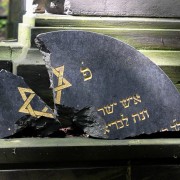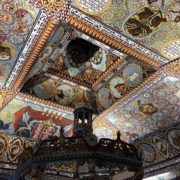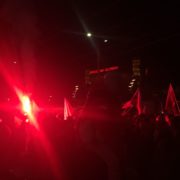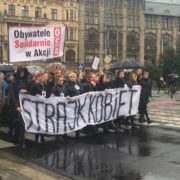A History of Anti-Ukrainian Sentiment in Poland
By Timothy Li
Although I have not personally attended the marches and rallies celebrating the Independence Day of Poland on November 11, I was quite surprised by the footages I saw featuring a more negative side of Polish nationalist culture. As I watched the rallies I also began to pay attention to the slogans and chants that the attendants were shouting, and besides the all too familiar anti-Semitic and anti-EU slogans, it was the anti-Ukrainian sentiment that really caught my attention. Prior to our time in Poland, I was aware of some historical tension between the Polish and Ukrainian nations, but it took me more time of researching to truly understand the tension that exists now in Polish society.
To trace the conflict between Poles and Ukrainians, the starting point has to be in the mid-16th century when the Kingdom of Poland and the Grand Duchy of Lithuania formed a union in 1569 (Union of Lublin). Unlike the tiny nation of Lithuania now, the Lithuania of the 16th-century was one of the largest countries in the entire European continent, including besides the modern-day country of Lithuania the Ukraine, Belarus, parts of Latvia and Russia. Even when religious tolerance was not commonplace in 16th-century Europe, Lithuania and Poland were both known as safe havens for heretics and religious reformers, and Catholics, Protestants, Orthodox Christians, Jews, and Muslims all coexisted side by side. While Poland was predominantly Catholic, Lithuania had an Eastern Orthodox majority that spoke Ukrainian and Belarusian, and only a minority that spoke the Baltic language of Lithuanian who adhered to Catholicism. Even though tolerance existed, there was still tension between members of the two denominations. With the Union of Lublin, Poland took over the Ukrainian part of the Grand Duchy of Lithuania and attempted to restore the union between its Orthodox and Catholic subjects, although oftentimes using persecution as a practical method. The Orthodox clergy was pressured by the Polish Catholic monarchy and clergy, and became part of the Catholic fold during the Union of Brest, and formed the basis of the modern-day Ukrainian Greek Catholic Church. It is important to understand that religion played an important role in shaping the national identities of Poles and Ukrainians.
While some switched loyalties to the Pope, the majority of Ukrainians stayed with the Orthodox church and often depended on the princes and tsars of Russia for assistance. The build-up of Polish-Ukrainian/Catholic-Orthodox tension reached breaking point in 1648 when the Khmelnitsky Uprising occurred. As the leader of the Cossacks (predominantly Ukrainian and Orthodox), Khmelnitsky could no longer accept the Polish monarchy’s pressure on Catholicization of the Ukrainians, and discrimination of Orthodox Slavs, and the existing system’s placement of Jews above Ukrainians. The creation of the Cossack Hetmanate was the first attempt since the long-lost Kievan Rus when the Ukrainians were represented as a nation (albeit under Russian control). The uprising was devastating to the Polish-Lithuanian Commonwealth and started what modern historians called the Deluge (1655 – 1660), when the once powerful and populous country of the Commonwealth entered into a stage of stagnation and decline. While the uprising’s main goal was to overthrow the Catholic sovereignty over the Cossacks, the Ukrainians and Cossacks also slaughtered countless Jews and Poles in the process.
The fortunes turned for the Poles when the Polish-Lithuanian Commonwealth fell in 1795 due to the encroachment of Prussia, Austria, and Russia, and the Poles did not have an independent state until 1918. The pious Russian monarchy favored the Orthodox Ukrainian subjects much more than the rebellious Catholic Poles, who fought against Russia as the Napoleonic client state of the Duchy of Warsaw and started multiple failed uprisings against the Russian government throughout the 19th century. But a turning point for both Poles and Ukrainians was the fall of the Russian Empire and its early departure from the Great War. Both nations are also similar in the way that they had the opportunity to exist as independent countries, but with no drawn borders. This led to Polish-Ukrainian relations falling to an all-time low during 1918-1919 when the two nations engaged each other in the Polish-Ukrainian War, which was part of the larger Ukrainian independence movement featuring battles between the Ukrainians, Poles, and Bolsheviks who all want Ukrainian territory. The important city of Lvov was ultimately taken by Poland and the majority of what constitutes Ukraine today being part of the new Soviet-controlled Ukrainian SSR. Even during our travels in Warsaw and Krakow, as well as our trips to NGOs with civil society, I have noticed the countless graffiti of the names “Wielka Polska” and sentences claiming Lvov being part of the Polish state.
Although only a fraction of society of both countries would outright claim territory from the other side, right-wing nationalism has grown in both countries during recent times. The invasion of Crimea by Russia led to the increased nationalism in Ukrainian society, and the threat of Russia and the perceived threat of EU globalization and increasing federalization only reminded Poland of its tragic past of the loss of statehood. Faced with threatening situations, increasing liberalization, and the slow loss of cultural identity, both countries are only succumbing to the act of human nature of finding a scapegoat, in the form of creating a common enemy with historical, and oftentimes nearly forgotten, facts of tension.








